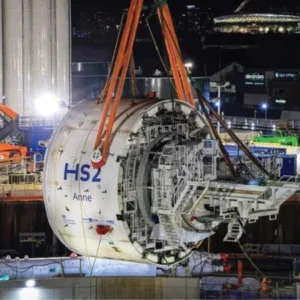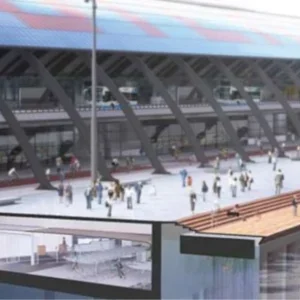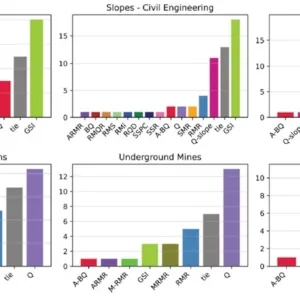It is difficult for any new method to break into the tunnelling market unless there is the potential for major costs savings. Natural conservatives say ‘why take the risk?’ if there is no obvious benefit, especially when design lifetimes are around 100 years. Even if there is costsaving potential, the method has to prove itself to all specifiers and customers on matters such as ease of installation, efficacy for the purpose, durability and safety. This is where performance criteria become important rather than demanding physical properties that should also be proven and may become outdated.
The introduction of spray-on waterbarrier membranes has, so far, mirrored the acceptance of sprayed concrete in that the attraction of potential cost-savings and apparent ease of application has been persuasive in many cases. Such is the similarity in approach that several suppliers and contractors are promoting a ‘sandwich approach’ to sprayed tunnel linings in which the water-barrier membrane is bonded within two or more layers of sprayed concrete.
There are a number of methods of water control that maybe employed:
Dewatering – mainly pumping from groundwater
Pregrouting – sealing ground fissures and pores before excavation
Remedial grouting – as above but during construction if ther is water ingress
Tanking – principally for cut and cover and immersed tube tunnels with sheet materials and liquid applied membranes
Gaskets – essential for pre-cast segmental lining and cast-in waterstops
Sheet membranes
Sprayed membranes
Waterproof concrete – produced by the use of special concrete mixes with additives to deter shrinkage and minimise porosity
Crystallisation – the use of crystalforming penetrative solutions to block pores in concrete
Plugging – including remedial grouting.
Sheet membranes
Construction materials specialists and plastics manufacturers supply sheet membranes, usually PVC, that are installed underground as part of the designed lining and prevent water ingress and/or divert it to drains. Some supplied for roofing or water reservoirs may not be suitable for the generally more demanding conditions of the underground environment. In addition there are thicker dimpled plastic sheets, such as those manufactured by Dorken, placed beneath the permanent structural lining and tunnel invert to facilitate water drainage.
Sheet membrane lining has long been criticised in some quarters due mainly to the potential for damage causing leaks that can be difficult to trace to source. The labour-intensive and sometimes complex nature of installation has also been a drawback to some, but often with few alternatives. The advent of sprayed membranes has put sheet membrane suppliers in a much more competitive situation, but one from which they are starting to fight back.
On the question of possible damage FLAG-Soprema produces a coextruded PVC membrane with the two surfaces in different colours. This means that any accidental holes in the material that may occur to the upper, light green surface during installation become immediately visible as the black colour of the lower layer shows through. Welding over a patch can repair any such damage.
Flag-Soprema’s Sarah Langley points out that its sheet membranes are of guaranteed thickness whereas the thickness of sprayed membranes depends on the operator’s efficiency and constant testing.
Recent Soprema sheet membrane installations include Bulgaria’s Sofia Metro Line Two, Rome Metro Line B1 and Line C and the new Tyne Tunnel.
Sika’s Sikaplan PVC and FPO tunnel membranes have been installed in the Gotthard Base Tunnel in conjunction with sprayed concrete lining. The lining system was subjected to pre-qualification testing in Switzerland’s Hagerbach testing gallery.
All successful sheet-membrane waterproofing installations depend on secure overlap joints between sheets carried out with welding or adhesives. These joints can be pressure tested afterwards. Some manufacturers offer Velcro fastening at sheet edges to aid joint assembly.
Sprayed membranes
As potentially the major development in underground waterproofing for many years, sprayed membranes form a rapidly increasing market sector, and are in competition with the established market for sheet membranes. The attraction of a waterproofing method that can be applied over asymmetrical or rough surfaces at a reduced labour cost is seductive, but the full story shows that it is not always that easy, and a lot of expertise has to be included in the process. Many suppliers now point out that the surface should be made fairly smooth, with a layer of fine concrete, before the sprayed membrane is applied.
Various established construction chemical and waterproofing specialists have, during the last decade, taken initial steps into the tunnelling market with liquidapplied membranes including BASF Meyco, Sika, Stirling Lloyd and Tam Normet. First projects have been completed, usually successfully, and more trials are under way to convince specifiers of the merits of application and durability. The basics have been well established in surface applications including immersed tube and cut and cover tunnels, nuclear containment, water services tanks and bridges. Application underground is more of a challenge in which clients and their engineers have taken an understandably cautious approach, as they had done with sheet membranes.
But sprayed lining suppliers, such as Stirling Lloyd, which offers the Integritank HF spray systems, as well as brush and spray-applied materials for open-air applications, do not claim that such membranes are a panacea for all waterproofing scenarios in any case. Indeed, sometimes both sheet and sprayed membranes have been used on different parts of the same project, depending on suitability for site conditions.
Bonding between sessions of sprayed lining can often be a problem but Stirling Lloyd’s development director, Mike Harper says not in their case. “The chemistry of the resins used in Integritank HF ensure that it will form a strong bond to itself irrespective of the time between applications,” he says. “The whole ethos of the system is based on this ability. The first coat is left to fully cure before the application of the second coat, so a true two coat system is provided.”
“At day joints [shift breaks] we ensure a totally seamless system by overlapping onto the existing material rather than butting up to it. These laps have been independently tested by The Technology Centre owned by Vinci Construction UK and found to be resistant to water pressure of 100 bar, when the test was concluded.”
Suitability for long-term durability and maintenance are major issues for both types of membrane, which programmes of trials and testing are being used to prove. Another common point is that both forms of membrane require skilled applicators with qualification supervision and quality assurance to ensure an effective installation. In the case of Stirling Lloyd’s Integritank HF the membrane’s integrity can be electronically tested in situ after installation, revealing even a pinhole defect.
Sandwiching
An extended development in the use of sprayed membranes is their use within a ‘sandwich’ such as in the case of Lasershell developed by Morgan Sindall and Bemo of Austria, and used on tunnels at London’s Kings Cross Station and London Heathrow Airport Terminal 5 (in joint venture with Vinci Construction Grands Projets) BASF Meyco is also now emphasising this means of using spray-applied membrane, and it is also offered by Stirling Lloyd for encapsulation on the primary sprayed concrete lining by the secondary (internal) lining, regardless of whether it is another layer of sprayed concrete or cast in situ. Recent installations of the company’s Integritank HF membrane include 20 000m2 to waterproof a sprayed concrete lined cavern in the Buenos Aires metro.
Using 20 000m2 of Stirling Lloyd’s Integritank HF membrane between two layers of sprayed concrete for a cavern in the Buenos Aires Metro, Argentina Soprema sheet waterproofing membrane used in cut-and-cover tunnelling for Line C of the Rome Metro






